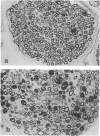Abstract
Non-freezing cold injury (NFCI), so called trench foot, is a condition characterised by a peripheral neuropathy, developing when the extremities are exposed for prolonged periods to wet conditions at temperatures just above freezing. Classically, military personnel are affected, with 14% of casualties in the Falklands conflict afflicted. Clinically, NFCI is characterised by a well-defined acute clinical picture and chronic sequelae. Little is known regarding the pathophysiology and treatment of this condition. Opinions vary as to the type of nerve fibres most susceptible to damage and proposed mechanisms of injury include direct axonal damage, ischaemia and ischaemia/reperfusion. A series of investigations has been performed to clarify which populations of nerve fibres are more susceptible to damage, and to elucidate the exact mechanism of nerve injury. An in vivo rabbit hind limb model, subjected to 16 h of cold immersion (1-2 degrees C), provided the basis of this study. Nerve specimens were examined by semi-thin sectioning for myelin fibre counts, by electron microscopy to assess the unmyelinated fibre population, and fine nerve terminals in plantar skin were assessed immunohistochemically. The results showed that large myelinated fibres were preferentially damaged, while small myelinated and unmyelinated fibres were relatively spared. Nerve damage was found to start proximally and extend distally with time. Serial temperature measurements identified a warm-cold interface in the upper tibial region of immersed limbs. As this was the initial site of injury, this suggested that a dynamic balance exists in the cold immersed limb between the protective effects of cooling and the damaging effects of ischaemia. The non-invasive technique of near infrared spectroscopy was used to measure changes in tissue oxygen supply and utilisation and blood volume. The findings supported the hypothesis that an interface is created at the site of initial nerve damage in the upper tibia, where cyclical ischaemia-reperfusion injury occurs.
Full text
PDF







Images in this article
Selected References
These references are in PubMed. This may not be the complete list of references from this article.
- Basbaum C. B. Induced hypothermia in peripheral nerve: electron microscopic and electrophysiological observations. J Neurocytol. 1973 Jun;2(2):171–187. doi: 10.1007/BF01474719. [DOI] [PubMed] [Google Scholar]
- Endrich B., Hammersen F., Messmer K. Microvascular ultrastructure in non-freezing cold injuries. Res Exp Med (Berl) 1990;190(5):365–379. doi: 10.1007/BF00000043. [DOI] [PubMed] [Google Scholar]
- Endrich B., Laprell-Moschner C., Brendel W., Messmer K. Effects of prolonged cold injury on the subcutaneous microcirculation of the hamster. I. Technique, morphology and tissue oxygenation. Res Exp Med (Berl) 1982;181(1):49–61. doi: 10.1007/BF01850989. [DOI] [PubMed] [Google Scholar]
- Francis T. J. Non freezing cold injury: a historical review. J R Nav Med Serv. 1984 Winter;70(3):134–139. [PubMed] [Google Scholar]
- Hughes B. THE CAUSES AND PREVENTION OF TRENCH FOOT. Br Med J. 1916 May 20;1(2890):712–714. doi: 10.1136/bmj.1.2890.712. [DOI] [PMC free article] [PubMed] [Google Scholar]
- Irwin M. S., Thorniley M. S., Doré C. J., Green C. J. Near infra-red spectroscopy: a non-invasive monitor of perfusion and oxygenation within the microcirculation of limbs and flaps. Br J Plast Surg. 1995 Jan;48(1):14–22. doi: 10.1016/0007-1226(95)90024-1. [DOI] [PubMed] [Google Scholar]
- Kennett R. P., Gilliatt R. W. Nerve conduction studies in experimental non-freezing cold injury: II. Generalized nerve cooling by limb immersion. Muscle Nerve. 1991 Oct;14(10):960–967. doi: 10.1002/mus.880141006. [DOI] [PubMed] [Google Scholar]
- Kocen R. S., King R. H., Thomas P. K., Haas L. F. Nerve biopsy findings in two cases of Tangier disease. Acta Neuropathol. 1973 Dec 3;26(4):317–327. doi: 10.1007/BF00688079. [DOI] [PubMed] [Google Scholar]
- Korthals J. K., Maki T., Gieron M. A. Nerve and muscle vulnerability to ischemia. J Neurol Sci. 1985 Dec;71(2-3):283–290. doi: 10.1016/0022-510x(85)90066-8. [DOI] [PubMed] [Google Scholar]
- Large A., Heinbecker P. Nerve Degeneration Following Prolonged Cooling of an Extremity. Ann Surg. 1944 Nov;120(5):742–749. doi: 10.1097/00000658-194411000-00006. [DOI] [PMC free article] [PubMed] [Google Scholar]
- MONTGOMERY H., HORWITZ O., PEIRCE G., SAYEN A. Experimental immersion foot. I. The effects of prolonged exposure to water at 3 degrees C. on the oxygen tension and temperature of the rabbit leg. J Clin Invest. 1954 Mar;33(3):361–369. doi: 10.1172/JCI102908. [DOI] [PMC free article] [PubMed] [Google Scholar]
- Nukada H., Pollock M., Allpress S. Experimental cold injury to peripheral nerve. Brain. 1981 Dec;104(Pt 4):779–811. doi: 10.1093/brain/104.4.779. [DOI] [PubMed] [Google Scholar]
- Ochoa J. Recognition of unmyelinated fiber disease: morphologic criteria. Muscle Nerve. 1978 Sep-Oct;1(5):375–387. doi: 10.1002/mus.880010506. [DOI] [PubMed] [Google Scholar]
- REDISCH W., BRANDMAN O., RAINONE S. Chronic trench foot: a study of 100 cases. Ann Intern Med. 1951 May;34(5):1163–1168. doi: 10.7326/0003-4819-34-5-1163. [DOI] [PubMed] [Google Scholar]
- SAYEN A., MELOCHE B. R., TEDESCHI G. C., MONTGOMERY H. Experimental immersion foot: observations in the chilled leg of the rabbit. Clin Sci. 1960 May;19:243–256. [PubMed] [Google Scholar]
- Schaumburg H., Byck R., Herman R., Rosengart C. Peripheral nerve damage by cold. Arch Neurol. 1967 Jan;16(1):103–109. doi: 10.1001/archneur.1967.00470190107013. [DOI] [PubMed] [Google Scholar]
- Schmelzer J. D., Zochodne D. W., Low P. A. Ischemic and reperfusion injury of rat peripheral nerve. Proc Natl Acad Sci U S A. 1989 Mar;86(5):1639–1642. doi: 10.1073/pnas.86.5.1639. [DOI] [PMC free article] [PubMed] [Google Scholar]
- Wrenn K. Immersion foot. A problem of the homeless in the 1990s. Arch Intern Med. 1991 Apr;151(4):785–788. doi: 10.1001/archinte.151.4.785. [DOI] [PubMed] [Google Scholar]




